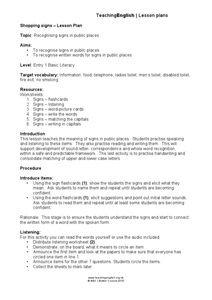Curated OER
The Life of Harriet Tubman
A well-designed lesson teaches about the history of Harriet Tubman, the Underground Railroad, and the issues of civil liberties. Young historians watch a video, access Internet resources, and engage in cooperative activities which should...
Center Science Education
Feeling the Heat
What is an urban heat island? Middle school meteorologists find out by comparing temperatures at different locations on campus. They relate their findings to what might be happening in a concrete jungle and how it impacts local weather....
Northeast Foundation for Children, Inc.
Schedules and Routines: Grade 1
It doesn't matter if you're a new teacher trying to set up your classroom for the first time or a veteran teacher looking for new ideas to freshen up your teaching, this resource has something to offer everyone. After providing a general...
Science 4 Inquiry
Atmospheric Layers
Space diving refers to the act of jumping from outer space and falling through Earth's atmosphere before parachuting to land. Scholars learn about this extreme activity and study the layers of the atmosphere they must conquer in the...
Science 4 Inquiry
States and Phases of Matter
Plasma is the most common phase of matter in our universe. Scholars explore the change of energy as molecules change phases of matter. They rotate through stations, graphing the changes in energy level.
Curated OER
The Extinction and Rediscovery of the Ivory-Billed Woodpecker
An incredibly thorough, and well-designed lesson teaches youngsters about the presumed extinction and rediscovery of the ivory-billed woodpecker in Arkansas. Learners discuss the environmental factors that led to the birds disappearance....
Curated OER
Autosomal Pedigrees Worksheet
Three autosomal pedigrees are printed on this assignment. Biology scholars read them and determine the phenotypes for several individuals and find which ones inherit different genetic disorders. This fundamental skill can be reinforced...
Curated OER
Photosynthesis and Respiration
Students comprehend the relationship between plants and animals in an aquatic ecosystem. They predict the effects of low dissolved oxygen on the organisms. Students create microcosms with plants, animals, or both. They determine which...
Curated OER
Living in an Igloo
Second graders read a book entitled, "Living in an Igloo." After observing the book, 2nd graders predict what will happen in the story. They explore the steps in building an igloo. Students review strategies they can use to decode...
Curated OER
SATP Multiple Choice II
Students explore strategies of identifying answers when given a multiple choice reading comprehension exam. Through a lecture and demonstration, students practice active reading by reading carefully, writing notes, and rereading. They...
Curated OER
A DAY IN THE LIFE OF A NURSE
Second graders examine the front cover of the book, A DAY IN THE LIFE OF A NURSE and discuss with a friend about a time they visited the hospital. They then read the book together as a class and review events. They make a list as a class...
Curated OER
Reading Weather Maps
Fourth graders the symbols that are used on weather maps. They develop five day forecasts based on information they gather from weather maps in the newspaper and on the Internet.
Curated OER
Words in the News: New Orleans Job Losses
Pupils discuss what they know about Hurricane Katrina and the city of New Orleans. In groups, they use they match the new vocabulary words to their definitions. They read an article about Hurricane Katrina and answer questions.
Curated OER
Make a Snowflake
Students study the design of snowflakes. In this snow lesson, students discover the different shapes of a snowflake, and their similarities. Students study snowflakes outside, then create their own with popsicle sticks and glue.
Curated OER
How Do We Make Wise Decisions In Our World?
Third graders participate in a case study and use their problem solving skills to address the solution to a given situation. They consider how to survive in a foreign country, make economic decisions, and determine wise decisions for...
Curated OER
"Fall"owing Changes in the Season
Students create a whole class A-B-"C"eason Book. Each student is responsible for creating a "letter" page relating to changes, adaptations, or other fall concepts. After hard copies of the class ABC books are created, the teachers using...
Curated OER
Making Cultural Connections
Students explore cultures through storytelling. They read African folktales. Students discuss characteristics of folktales. They research and write a folktale that includes an animal. Additional cross curriculum activities are included.
Curated OER
Recognizing Signs in Public Places
Students explore symbols by identifying public signage. In this public safety lesson, students view flashcards of everyday road, fire and food signs while discussing their function and purpose. Students record and identify road and...
Curated OER
The most commonly misspelled words in English
Ninth graders examine the different misspelled words in the English language. In this English lesson plan, 9th graders read an article and answer guided reading questions. Students write an email to their teacher about what they have read.
Curated OER
Researching Animals Portrayed in Fables
Students research an animal used in fables. In this lesson on nonfiction texts, students use the Internet to find information about an animal to help them complete a Research Response Sheet.
Curated OER
Active Reading: Finding a Conversation Voice
Young scholars practice reading for comprehension and understanding. In groups, students read, out loud, using a conversation voice. They predict and discuss the story as it unfolds.
Virginia Department of Education
Weather Patterns and Seasonal Changes
Get your class outside to observe their surroundings with a lesson plan highlighting weather patterns and seasonal changes. First, learners take a weather walk to survey how the weather affects animals, people, plants, and trees during...
EngageNY
Writing and Evaluating Expressions—Exponents
Bring your young mathematicians into the fold. Scholars conduct an activity folding paper to see the relationship between the number of folds and the number of resulting layers in the 23rd installment of a 36-part module. The results of...

























